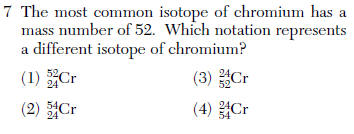Questions
(1) atomic mass (3) mass number
(2) atomic number (4) oxidation number
(1) an alpha particle (3) a neutron
(2) a beta particle (4) a positron
proton 1 amu
(1) 1 (3) 13
(2) 2 (4) 17
(1) An electron in the first shell has more energy than an electron in the second shell.
(2) An electron in the first shell has the same amount of energy as an electron in the second shell.
(3) An electron in the third shell has more energy than an electron in the second shell.
(4) An electron in the third shell has less energy than an electron in the second shell.
(1) circular path traveled by an electron around the nucleus
(2) spiral path traveled by an electron toward the nucleus
(3) region of the most probable proton location
(4) region of the most probable electron location
(1) the total number of neutrons in the atom, only
(2) the total number of protons in the atom, only
(3) the total number of protons and the total number of neutrons in the atom
(4) the total number of protons and the total number of electrons in the atom
atomic number are the # of protons

(1) tin (3) lead
(2) silicon (4) carbon
(1) As (3) P
(2) Bi (4) Sb
(1) CO (3) Ca
(2) Ce (4) Cu